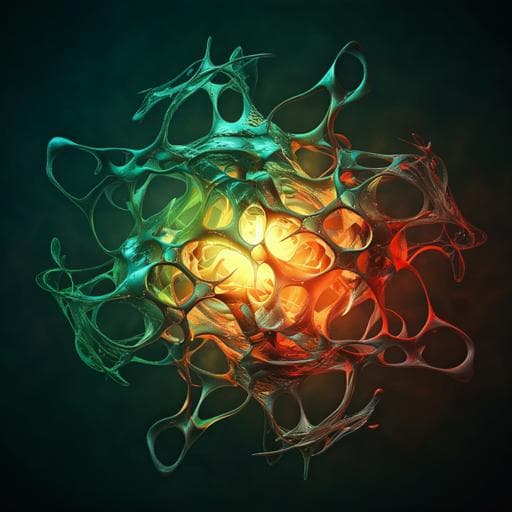
Chemistry
Direct cleavage of C=O double bond in CO₂ by the subnano MoO<sub>x</sub> surface on Mo₂N
H. Liu, W. Wang, et al.
This groundbreaking study by Hao-Xin Liu, Wei-Wei Wang, Xin-Pu Fu, Jin-Cheng Liu, and Chun-Jiang Jia unveils a novel MoOₓ/Mo₂N catalyst that dramatically enhances CO₂ hydrogenation efficiency to carbon monoxide, leveraging rich oxygen vacancies to cleave C=O bonds at impressive rates. Join us in exploring the future of CO₂-related synthesis!
~3 min • Beginner • English
Introduction
Rising CO2 emissions drive global warming, but CO2 is also a valuable, though inert, carbon feedstock for chemicals and fuels. In CO2-related synthesis, carbonyl (*CO) is a key platform intermediate formed either by H2-assisted CO2 activation (via hydrogenated intermediates) or by direct CO2 dissociation to *CO. Most homogeneous and heterogeneous catalysts follow the H2-assisted mode, which complicates reaction networks and imposes stringent catalyst requirements. Direct cleavage of the thermodynamically stable C=O double bond in CO2 would simplify pathways but is difficult to realize. Oxygen vacancies on reducible oxides can aid CO2 activation; however, conventional oxides often leave coordinatively unsaturated metal cations that donate insufficient electrons to CO2 anti-bonding orbitals, limiting direct C=O scission. Molybdenum nitride/carbide catalysts are highly active in C1 chemistry, and prior work indicated that a MoO3 passivation layer on bulk Mo2N has low oxygen-vacancy formation energy and can act as the intrinsic active surface. This work aims to exploit the ultra-active redox behavior of a subnano MoO3 passivation layer on Mo2N, forming a dynamically reduced MoOx (1 < x < 3) surface rich in oxygen vacancies capable of directly dissociating CO2 and efficiently catalyzing the reverse water gas shift (RWGS) reaction without supported noble metals.
Literature Review
Defect engineering on reducible oxides has been widely used to enhance CO2 activation through oxygen vacancies, which modulate catalyst electronic/geometric structures and can act as adsorption/activation sites. Yet, on conventional oxides, exposed metal sites typically donate weakly to CO2 anti-bonding orbitals, hindering C=O cleavage. Molybdenum nitride/carbide systems (MoC, Mo2C, Mo2N) have shown high activity in C1 chemistry; however, activity is commonly attributed to the bulk phase, often overlooking the role of MoO3 passivation layers. Prior studies identified the MoO3 passivation surface on γ-Mo2N as the intrinsic active surface in Pt/Mo2N for WGS, and that Pt clusters synergize with vacancies on defective MoOx (x < 3) to enhance H2-assisted CO2 activation. Despite these advances, dissociative CO2 activation remained elusive on relatively ordered MoOx surfaces. CeO2, a prototypical reducible oxide, typically binds CO2 strongly to form carbonates rather than enabling direct dissociation, aligning with associative RWGS pathways and underscoring the need for alternative defect-rich surfaces with stronger electron donation to achieve direct C=O bond scission.
Methodology
Catalyst synthesis: MoO3 was synthesized hydrothermally (P123 templating; Na2MoO4·9H2O, HCl; 100 °C, 12 h; calcined 400 °C, 4 h). MoO3/Mo2N was obtained by nitriding MoO3 under NH3 (650 °C, 4 h), followed by passivation in 1% O2/Ar. The as-prepared material is denoted MoO3/Mo2N; under Ar/H2/RWGS flows it forms MoOx/Mo2N (1 < x < 3). Characterization: XRD (ex situ/in situ) to identify bulk phases and stability under H2 and RWGS; Raman (ex situ/in situ) to monitor surface Mo–O species and redox dynamics under air/Ar/H2/CO2/RWGS; XPS (ex situ and quasi in situ) including Mo 3d, O 1s, N 1s, with Ar ion etching for surface/subsurface analysis; TEM, HRTEM, HAADF-STEM, STEM-EDS mapping and line scanning for morphology and surface layers; SEM for morphology. Redox and surface chemistry: H2-TPR (to 600 °C and 950 °C) for reducibility and quantification of reduced oxygen (−1905 µmol g−1 from RT–600 °C; −2844 µmol g−1 total, yielding x ≈ 1.0 after 600 °C pretreatment). CO-TPR to confirm Mo–O reduction. CO-TPD after H2 pretreatment (600 °C) to assess CO binding/desorption. Surface reaction protocols: Four-step sequence (Ar → CO2 → Ar → H2) at 600 °C to probe direct CO2 dissociation to CO and H2-assisted O removal (H2O formation), cycled three times. CO2 treatment experiments (2% CO2/Ar, 600–800 °C) on H2-pretreated and non-pretreated samples to assess oxidation effects; analogous tests on H2-reduced CeO2 included DRIFTS to probe carbonate formation. CO2-TPD compared CO2 adsorption propensities (MoOx/Mo2N vs CeO2). Catalytic testing: RWGS in a fixed-bed reactor using 15 mg catalyst, GHSV 200,000 mL gcat−1 h−1, 0.1 MPa, feed 23% CO2/69% H2 in Ar, 300–600 °C; CO selectivity and conversions via GC. Kinetics: Apparent activation energies with conversions below 15%; variable WHSV using 3 mg catalyst; CO formation rates up to very high GHSV (3,800,000 mL gcat−1 h−1). Stability: Three 300 h runs at 600 °C (total 900 h) with 55-day air exposure intervals, and tests at elevated pressures (1.0–2.0 MPa). Computational: DFT models of MoO3/Mo2N and MoOx/Mo2N with varying oxygen-vacancy densities (20v–140v) to evaluate CO2 adsorption configurations/energies, electron transfer (projected DOS, differential charge density), and reaction energetics for direct CO2 dissociation vs carbonate pathways; comparison with reduced CeO2. Key barriers evaluated: CO2 dissociation to *CO + *O (1.50 eV), H2 dissociative adsorption (0.97 eV), and *H + *OH → H2O (1.23 eV).
Key Findings
- A subnano MoO3 passivation layer on bulk Mo2N undergoes facile in situ reduction to MoOx (1 < x < 3) with high-density oxygen vacancies that directly dissociate CO2 to CO via C=O bond cleavage (CO2 → CO + O_surface), evidenced by four-step surface reaction experiments producing CO upon CO2 exposure and H2O upon subsequent H2 exposure.
- H2-TPR quantification shows −1905 µmol g−1 O removed between RT–600 °C and −2844 µmol g−1 total to 950 °C; after 600 °C H2 pretreatment the average surface stoichiometry approaches MoO1.0 (x ≈ 1.0), implying abundant vacancy formation.
- In situ Raman reveals dynamic redox: MoO3 → defective MoOx under Ar/H2 (even at RT), re-oxidized by CO2, and reversible across cycles; at high T, Raman signals are masked but XPS confirms persistent Mo–O species.
- HAADF-STEM after RWGS shows a disordered subnano (<1 nm) surface layer; STEM-EDS mapping/line scans confirm surface Mo–O species; XPS shows reduced Mo states and increased adsorbed oxygen species consistent with vacancy formation; bulk γ-Mo2N remains stable under H2/RWGS by in situ XRD.
- Catalytic performance (RWGS, 0.1 MPa, 23% CO2/69% H2, GHSV 200,000 mL gcat−1 h−1): at 600 °C, CO2 conversion ~48% (near equilibrium), CO selectivity 100%; six start-up/cool-down cycles show reproducibility. Apparent activation energy Ea = 45.0 kJ mol−1, lower than CeO2 (102.1 kJ mol−1) and comparable to Pt/CeO2 (55.6 kJ mol−1). CO rate reaches 1.596×10−3 mol gcat−1 s−1 at GHSV 3,800,000 mL gcat−1 h−1.
- Long-term durability: stable conversion (>45%) and 100% CO selectivity over 900 h at 600 °C with two 55-day air exposure intervals, indicating recyclability and absence of metal-sintering deactivation (no supported metals).
- Mechanistic distinction vs CeO2: H2-reduced CeO2 forms stable carbonates (DRIFTS) without CO evolution under analogous conditions, indicating associative pathway; MoOx/Mo2N shows weak CO2 carbonate formation (CO2-TPD) and weak CO binding (no CO desorption to 600 °C), favoring redox pathway and preventing methanation.
- DFT: Increasing vacancy density strengthens CO2 chemisorption (Eads from ≈ −0.2 to −1.2 eV across 20v→140v) and enables multi-site activation with electron transfer from coordinatively unsaturated Mo to CO2 antibonding orbitals; direct C=O cleavage barrier is 1.50 eV, lower than carbonate formation (1.77 eV). H-assisted steps (H2 dissociation 0.97 eV; *H + *OH to H2O 1.23 eV) are easier than CO2 dissociation, identifying CO2 scission as rate-limiting.
- Reaction conditions sensitivity: High H2/CO2 ratio (e.g., 3:1) is required to regenerate vacancies and prevent bulk Mo2N oxidation; at lower ratios (2:1, 1:1), MoO2 forms and activity declines.
Discussion
The study demonstrates that engineering a subnano, vacancy-rich MoOx surface on Mo2N enables direct cleavage of the CO2 C=O bond, addressing the long-standing challenge of CO2 activation without relying on H2-assisted associative pathways. The coordinatively unsaturated Mo centers adjacent to oxygen vacancies provide strong electron donation into CO2 antibonding orbitals, facilitating multi-atom bonding and direct dissociation. The redox cycle—CO2 dissociation creating surface O, followed by rapid H2-mediated removal as H2O—maintains a high density of active vacancies, which explains the low apparent activation energy, near-equilibrium conversions, full CO selectivity, and exceptional long-term stability at high GHSV. Weak CO binding expedites product desorption, suppressing methanation. Compared with CeO2, which predominantly forms carbonates, the MoOx/Mo2N heterostructure enables a true redox RWGS mechanism. The findings clarify that the overlooked MoO3 passivation layer on Mo2N is intrinsically active and dynamically transforms to the operative MoOx surface under reaction, while the Mo2N bulk confers structural stability in reductive atmospheres. This mechanistic insight provides a blueprint for designing heterostructured, defect-rich oxide surfaces that deliver high-temperature RWGS performance without precious metals.
Conclusion
By exploiting the ultra-active redox properties of a subnano MoO3 passivation layer on Mo2N, this work constructs a dynamically reduced, oxygen-vacancy-rich MoOx surface that directly cleaves the C=O bond in CO2, enabling an efficient redox RWGS pathway. The catalyst achieves near-equilibrium CO2 conversion with 100% CO selectivity at 600 °C, low activation energy, high space velocities, and remarkable 900 h stability without supported metals. DFT and in situ experiments establish that high-density vacancies and multi-site Mo electron donation are essential for direct CO2 dissociation, with CO2 scission as the rate-limiting step. The results highlight the intrinsic activity of MoO3/MoOx surfaces on Mo2N and open avenues for heterostructure-based defect engineering to activate stable molecules. Future work could generalize this design principle to other nitride/oxide systems, optimize vacancy densities under milder conditions, and explore broader reactions requiring strong bond activation.
Limitations
- The catalyst requires sufficiently high H2 partial pressures (e.g., H2/CO2 ≈ 3:1) to continuously remove oxygen and regenerate vacancies; at lower ratios (2:1 or 1:1), bulk Mo2N undergoes over-oxidation to MoO2 with diminished performance.
- High operating temperatures (up to 600 °C) are needed to achieve near-equilibrium conversions and overcome CO2 dissociation barriers.
- Spectroscopic limitations: at elevated temperatures the MoOx Raman signal is masked by thermal emission, and the dark color of MoO3/Mo2N hinders detection of surface intermediates by DRIFTS, necessitating indirect corroboration.
- The direct dissociation pathway relies on maintaining a high density of oxygen vacancies; performance may be sensitive to surface reconstruction or poisoning under different feeds or impurities.
Related Publications
Explore these studies to deepen your understanding of the subject.







